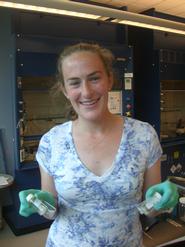
To the naked eye, the simple glass beads all over the lab of Meghan Carter ’12 are not very exciting. However, under UV light, the beads glow different colors depending on their composition. Working under Associate Dean of Students for Academics and Professor of Chemistry Karen Brewer, Carter is trying to increase the fluorescence of these beads.
Like regular glass, the beads are made from a solidified silica matrix in a process called solution-gelation (sol-gel). The organic, multidentate ligands, or molecules that can bond to multiple sites, are wrapped around decrease a conductive rare earth metal. Ligands do decrease the fluorescence, but they are necessary to keep the glasses in one piece. As in the project of Professor of Physics Ann Silversmith's research students, the sol-gels are extremely porous and become “quenched,” or compromised by water that condenses from the air. By protecting the rare earth metal by wrapping it with ligands, some of the quenching can be stopped. Carter is trying to get the best of both worlds: sol-gels that still fluoresce brightly but are protected from quenching.
Rare earth metals are very fluorescent because they have a lot of electrons at high energy levels, making them easily excitable; it is this excitement and subsequent release of electrons that causes the emission of light. Each bead emits light at a different wavelength, or color, depending on the rare earth metal used to make it: europium, for example, consistently glows orange, terbium green. When a ligand is wrapped around the rare earth metal, however, it acts as a medium for the energy that would otherwise excite the rare earth. The ligands can hold, pass on, or bounce back the energy being put into them, which may increase or decrease the fluorescence. Carter’s goal, through much experimentation, is to build upon and change the type of ligands that have been proven to fluoresce while still protecting the sol-gel against quenching.
For Carter, the project is a unique blend of different types of chemistry. “It’s an interesting mix of organic and inorganic chemistry,” she said. “I like how they get to interact and change each other.” The only known premed sociology major in Hamilton’s history, Carter is a member of the varsity field hockey team and an Alternative Spring Break leader. She hopes to become a pediatrician after graduating from Hamilton and plans to study abroad in Chile in the spring.
Carter's summer research was funded through the Edward and Virginia Taylor Fund for Student/Faculty Research in Chemistry, established in 2008 through a gift from Ted ’46 and Virginia to inspire students interested in chemical research and to facilitate their work with outstanding faculty.
Carter graduated from the National Cathedral School in Washington, D.C.
Like regular glass, the beads are made from a solidified silica matrix in a process called solution-gelation (sol-gel). The organic, multidentate ligands, or molecules that can bond to multiple sites, are wrapped around decrease a conductive rare earth metal. Ligands do decrease the fluorescence, but they are necessary to keep the glasses in one piece. As in the project of Professor of Physics Ann Silversmith's research students, the sol-gels are extremely porous and become “quenched,” or compromised by water that condenses from the air. By protecting the rare earth metal by wrapping it with ligands, some of the quenching can be stopped. Carter is trying to get the best of both worlds: sol-gels that still fluoresce brightly but are protected from quenching.
Rare earth metals are very fluorescent because they have a lot of electrons at high energy levels, making them easily excitable; it is this excitement and subsequent release of electrons that causes the emission of light. Each bead emits light at a different wavelength, or color, depending on the rare earth metal used to make it: europium, for example, consistently glows orange, terbium green. When a ligand is wrapped around the rare earth metal, however, it acts as a medium for the energy that would otherwise excite the rare earth. The ligands can hold, pass on, or bounce back the energy being put into them, which may increase or decrease the fluorescence. Carter’s goal, through much experimentation, is to build upon and change the type of ligands that have been proven to fluoresce while still protecting the sol-gel against quenching.
For Carter, the project is a unique blend of different types of chemistry. “It’s an interesting mix of organic and inorganic chemistry,” she said. “I like how they get to interact and change each other.” The only known premed sociology major in Hamilton’s history, Carter is a member of the varsity field hockey team and an Alternative Spring Break leader. She hopes to become a pediatrician after graduating from Hamilton and plans to study abroad in Chile in the spring.
Carter's summer research was funded through the Edward and Virginia Taylor Fund for Student/Faculty Research in Chemistry, established in 2008 through a gift from Ted ’46 and Virginia to inspire students interested in chemical research and to facilitate their work with outstanding faculty.
Carter graduated from the National Cathedral School in Washington, D.C.
Posted August 15, 2010
